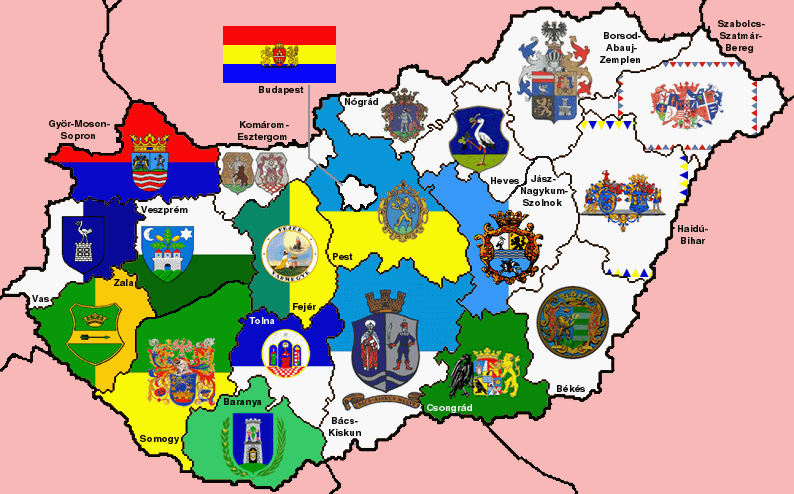
by Antonio Broto, 7 August 2001

Last modified: 2003-06-07 by dov gutterman
Keywords: hungary | subdivisions | wolf teeth |
Links: FOTW homepage |
search |
disclaimer and copyright |
write us |
mirrors

by Antonio Broto, 7 August 2001
See also:
Other Sites:
Subdivisions of Hungary (1 January 1999) - Hungary is divided
to 19 county (megye), 1 capital (fováros) and 22 cities (like
county by right / megyei jogú város). The cities are not
part of the counties.
In 1 July 2000. many "large community" has became
towns.
István Molnár, 4 July 2000
Most of the visited villages made a horizontal flag (ratio
2:3) and a vertical flag (ratio 5:2). The name of the horizontal
flag is "zászló" or "lobogó", the name of
the vertical flag is " "labarum" " or
"függönyzászló"
István Molnár, 8 August 2000
Every piece of territory of Hungary must by law to be part of
some community or city. In Hungary before we had five types of
settlements:
1. Község (community).
2. Nagyközség (large community). This type of settlement does
not really exist any more as a separate category. Before,
communities, when their population became larger, were awarded
with the title of "large community". Now, there is no
specific procedure for the title "large community". All
former large communities retain their title, but no such new
titles are awarded. Now, all communities with a population of
5000 or more people can use the title of large community, without
any official procedure, if they wish so. For example, the
community, where I live, has 6000 people, but the title of large
community is not used by the local authorities.
3. Város (city). The title of city is given by the head of
state, there are no specific requirements, but in order to apply
for the status of city, a community is expected to have a high
school, permanent police station, permanent medical service,
cultural institutions.
4. Megyei jogú város (city with right of county). Now the
capitals of all counties are automatically given the title of
"city with right of county" (before, only 16 of the 19
county capitals had such title, now all 18 (!) county capitals
have this title). Also all cities with a population of 50
thousands can apply for this status. Now we have 3 cities with
right of county that are not capital of any county. Cities with
right of county are de iure not considered part of the county
where they are located, but the de facto they are part of them
(the only exception is Pest county, whose capital - Budapest - is
outside the county, de iure and de facto). The main difference
between a "normal" city and a "city with right of
county" is that a normal city offer services only to its own
habitants and to surrounding communities, while a "city with
right of county" offer services to a larger region,
including to surrounding cities.
5. Fováros (capital) - the capital is divided to smaller parts,
disctricts, that have their own local autonomy, powers are shared
with the capital's local autonomy.
Ivan Marinov, 14 March 2001
1. Község - I use the word: village. This settlement type
exists from 1876. Before 1876 they were named as 'Falu' means
village. The official name of these settlements are 'Község',
the used version 'Falu'. In the 1900-1910s these settlements were
named
'Kisközség' - It means 'Little Community' but I don't use the
word "community" because it is not the same as the
village (for example in Yugoslavia, Romania and Ukraine one
community contains more settlements as a district).
Between 1950-1989 in Hungary there were some communities which
contained more villages. These villages became independent
settlements after 1989. In Slovakia too.
2. Nagyközség - This settlement type exists from 1876 when some
formerly 'Mezováros' - means borough (town)- lost its town type
rights and didn't become 'Rendezett Tanácsú Város' - means
'City with Council' (town). They became 'Nagyközség'. Most of
them became town (last in August 2000: Harkány, Szob,
Pannonhalma, Visegrád etc.). Inhabitants these formerly 'large
villages' or 'large communities': Harkány: 3.587, Szob: 2.803,
Pannonhalma: 3.524, Visegrád: 1.543.
3. V